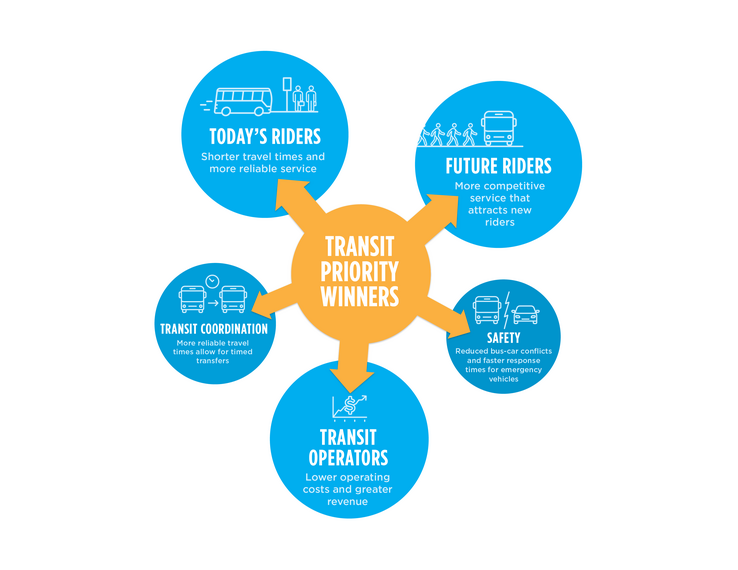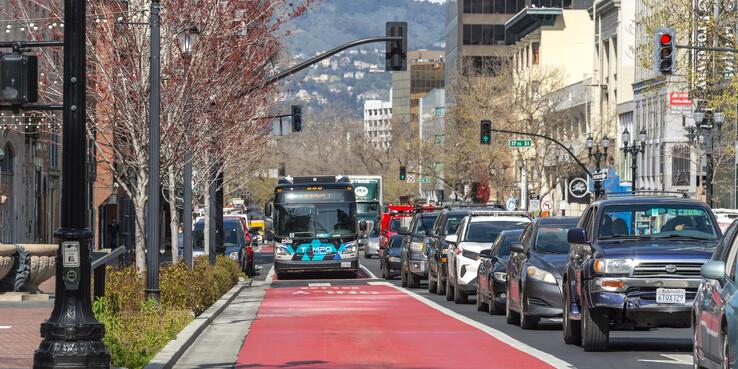A recent SPUR report describes the multiple challenges a typical Bay Area bus trip can entail and highlights the ways that bus riders and other transit users often don’t get a fair shake when it comes to transportation investments. Making Roads Work for Transit: Strategies to Accelerate Bay Area Transit Priority Treatments argues that continuing to privilege convenience for cars is jeopardizing equity and climate goals — as well as transit’s fiscal sustainability. The author, Transportation Policy Manager Jonathon Kass, says that several factors are creating momentum to make transit on roadways faster and more reliable. His recommendations — derived from the insights of a task force of transit experts, operators, and advocates — lay out a roadmap for the Metropolitan Transportation Commission, Caltrans, and California cities and counties to come together to greenlight transit-friendly roadway design and operations. We spoke with Jonathon about transit priority’s benefits and how they can be realized.
Before we get to the report, can you tell us about the recent big transit priority win in San Francisco?
Talk about delayed gratification! In August, San Francisco transit officials unanimously approved transit-only lanes on Geary Boulevard. SPUR had been advocating for this action since 2003, when SF voters funded it with passage of a sales tax. But the project has always faced pockets of neighborhood and business opposition. It would probably have been stuck for many more years without SB 922 — sponsored by SPUR — which exempts such obviously beneficial transit projects from the California Environmental Quality Act. That legislation prevents a few opposing voices from watering down transit improvements. The transit-only lanes on Geary will speed up the 38-Geary buses, helping tens of thousands of transit riders. It’s the kind of project our report calls for across the region.
What are transit priority treatments?
They are much more than just bus lanes. Transit priority treatments include roadway design, operations, and traffic enforcement that can help buses and other transit vehicles avoid traffic congestion, reduce delays at signals, and move more predictably on all types of roads. Roadway design might take the form of dedicated transit-only lanes or queue jump lanes, which help transit vehicles move to the front of traffic waiting at a signal. Operations could be real-time traffic signal adjustments to minimize delay of transit vehicles. Enforcement might focus on traffic violations that contribute to the most transit route disruptions, such as vehicles illegally blocking transit stops and transit routes.
The Bay Area is in danger of a transit death spiral. How would investments in transit priority help?
Transit in California got a boost in the most recent state budget, but some of the biggest Bay Area transit operators are still looking at service cuts without more funding. This at a time when they need to be expanding and improving service to become financially sustainable. Greater transit priority on the region’s roads creates a virtuous circle. First, it allows transit operators to deliver more service with the same budget because they can provide more frequency and capacity if buses aren’t getting stuck. By increasing service quality, transit priority treatments can provide a better experience for current transit users and attract new ones. More ridership gives transit the fare revenues it needs to survive and thrive. Not to mention that getting people out of cars and on transit will mitigate greenhouse gas emissions.

Your report argues that transit priority investments are not only about sustaining transit and meeting climate goals. What else is at stake?
Equity. Let’s look at who rides buses now. It’s primarily people for whom buying, maintaining, or driving a car is not an option. It’s elderly people, young people, people of color, and lower-income riders. Choosing not to make transit priority investments is choosing not to serve those who would benefit most from high-quality transit and those for whom more is at stake when transit fails — like getting to school on time, getting to a doctor’s appointment, buying groceries, or getting to an hourly job where clocking in late can mean docked pay.
Because buses are not prioritized on roadways, many people have had an experience where the bus was late, or they were stuck in traffic. Busses are then perceived as the less convenient choice for many people – and so ridership is not what it could be. Without transit priority treatments to speed up buses and make them more reliable, ridership can’t grow.
Inequitable, unsustainable, and inefficient. That’s how your report assesses the growing segregation of the transit system. How does making buses faster and more reliable address these problems?
With proper prioritization on our roadways, buses can get many more people to destinations in a less stressful, less polluting, and less costly manner than private vehicles. Making buses faster and more reliable can open greater access to opportunity and everyday necessities.
The problem is that decisionmakers consistently fail to value the ridership growth that would result from bus speed and reliability improvements. Generally, cities and counties have the power to make local road decisions, and they have wielded it to privilege convenience for car drivers.
How is the calculus changing?
Today we have increasing congestion, extraordinary transit fiscal challenges, and agencies more acutely serving the needs of working-class and lower-income residents of the Bay Area. It’s clear that the region and state need to properly empower, fund, and encourage transit agencies, cities, and counties to deliver the many wins that follow from transit priority investments.
The good news is that transit operators and regional and state leaders increasingly agree on the need for transit priority interventions. New tools to streamline environmental review have eliminated some barriers to delivering these interventions. And regional transit planning efforts by the Metropolitan Transportation Commission and Caltrans will create opportunities to define greater authority for and investment in transit priority efforts.
